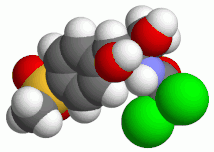Thiamphenicol (also known as thiophenicol and dextrosulphenidol) is an antibiotic.[1] It is the methyl-sulfonyl analogue of chloramphenicol and has a similar spectrum of activity, but is 2.5 to 5 times as potent. Like chloramphenicol, it is insoluble in water, but highly soluble in lipids. It is used in many countries as a veterinary antibiotic, but is available in China, Morocco and Italy for use in humans. Its main advantage over chloramphenicol is that it has never been associated with aplastic anaemia.[2]
 | |
 | |
| Clinical data | |
|---|---|
| Trade names | Urfamycin |
| AHFS/Drugs.com | International Drug Names |
| Routes of administration | IV, IM, oral |
| ATC code | |
| Pharmacokinetic data | |
| Metabolism | hepatic |
| Elimination half-life | 5.0 hours |
| Excretion | renal |
| Identifiers | |
| |
| CAS Number | |
| PubChem CID | |
| DrugBank | |
| ChemSpider | |
| UNII | |
| KEGG | |
| ChEBI | |
| ChEMBL | |
| CompTox Dashboard (EPA) | |
| ECHA InfoCard | 100.035.762 |
| Chemical and physical data | |
| Formula | C12H15Cl2NO5S |
| Molar mass | 356.21 g·mol−1 |
| 3D model (JSmol) | |
| Melting point | 164.3 to 166.3 °C (327.7 to 331.3 °F) |
| |
| |
| | |
Thiamphenicol is also widely used in Brazil, particularly for the treatment of sexually transmitted infections and pelvic inflammatory disease.[3]
Unlike chloramphenicol, thiamphenicol is not readily metabolized in cattle, poultry, sheep, or humans, but is predominantly excreted unchanged. In pigs and rats the drug is excreted both as parent drug and as thiamphenicol glucuronate.[2]
Thiamphenicol can be administered as a part of a complex molecule, Thiamphenicol glycinate acetylcysteine.[4]
References
edit- ^ Fisch A, Bryskier A (2005). "Chapter 33 : Phenicols". In Bryskier A (ed.). Antimicrobial Agents. American Society for Microbiology. doi:10.1128/9781555815929.ch33.
- ^ a b Francis PG (1997). "Thiamphenicol". Residues of some veterinary drugs in animals and foods. FAO Food and Nutrition Paper (41/9). Rome: Food and Agriculture Organization (FAO), World Health Organization (WHO). ISBN 92-5-103972-0.
- ^ Fuchs FD (2004). "Tetraciclinas e cloranfenicol". In Fuchs FD, Wannmacher L, Ferreira MB (eds.). Farmacologia clínica: fundamentos da terapêutica racional (in Portuguese) (3rd ed.). Rio de Janeiro: Guanabara Koogan. pp. 375. ISBN 0-7216-5944-6.
- ^ Serra A, Schito GC, Nicoletti G, Fadda G (2007). "A therapeutic approach in the treatment of infections of the upper airways: thiamphenicol glycinate acetylcysteinate in sequential treatment (systemic-inhalatory route)". International Journal of Immunopathology and Pharmacology. 20 (3): 607–617. doi:10.1177/039463200702000319. PMID 17880774.
Further reading
edit- Marchese A, Debbia EA, Tonoli E, Gualco L, Schito AM (December 2002). "In vitro activity of thiamphenicol against multiresistant Streptococcus pneumoniae, Haemophilus influenzae and Staphylococcus aureus in Italy". Journal of Chemotherapy. 14 (6): 554–561. doi:10.1179/joc.2002.14.6.554. PMID 12583545. S2CID 22843552.
- Raymond J, Boutros N, Bergeret M (2004). "[Role of thiamphenicol in the treatment of community-acquired lung infections]". Medecine Tropicale. 64 (1): 33–38. PMID 15224555.